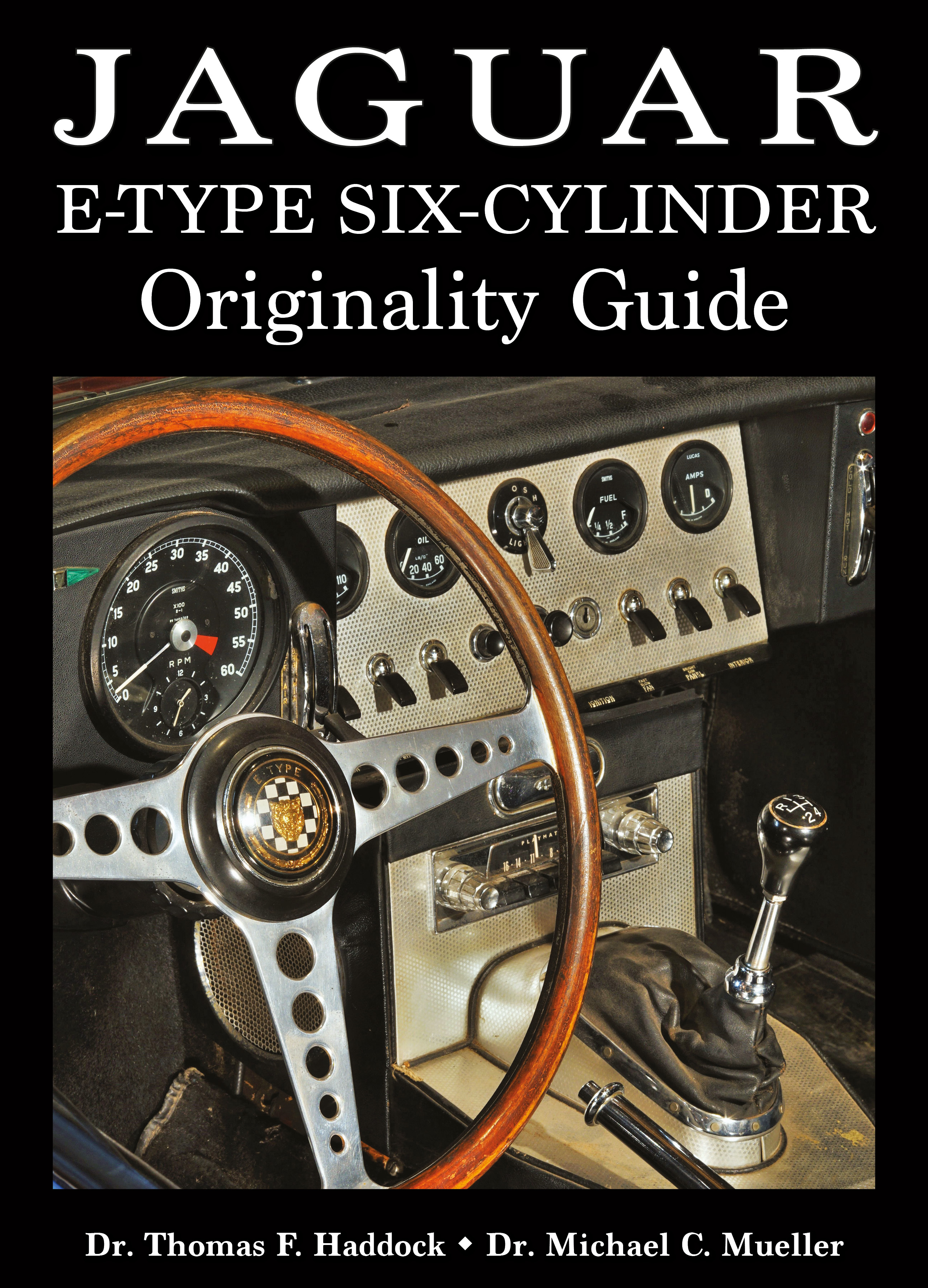
|
|
|
|
|
|
Triple SU HD8 carburetor set, as fitted to early E-types
While all of the S-type XK engines fitted to the Series 1 E-type cars (as well as MkX sedans) had triple SU HD8 carburetors, the design of the carburetors and manifolds evolved over time.
This set shows a relatively early configuration.
|
|
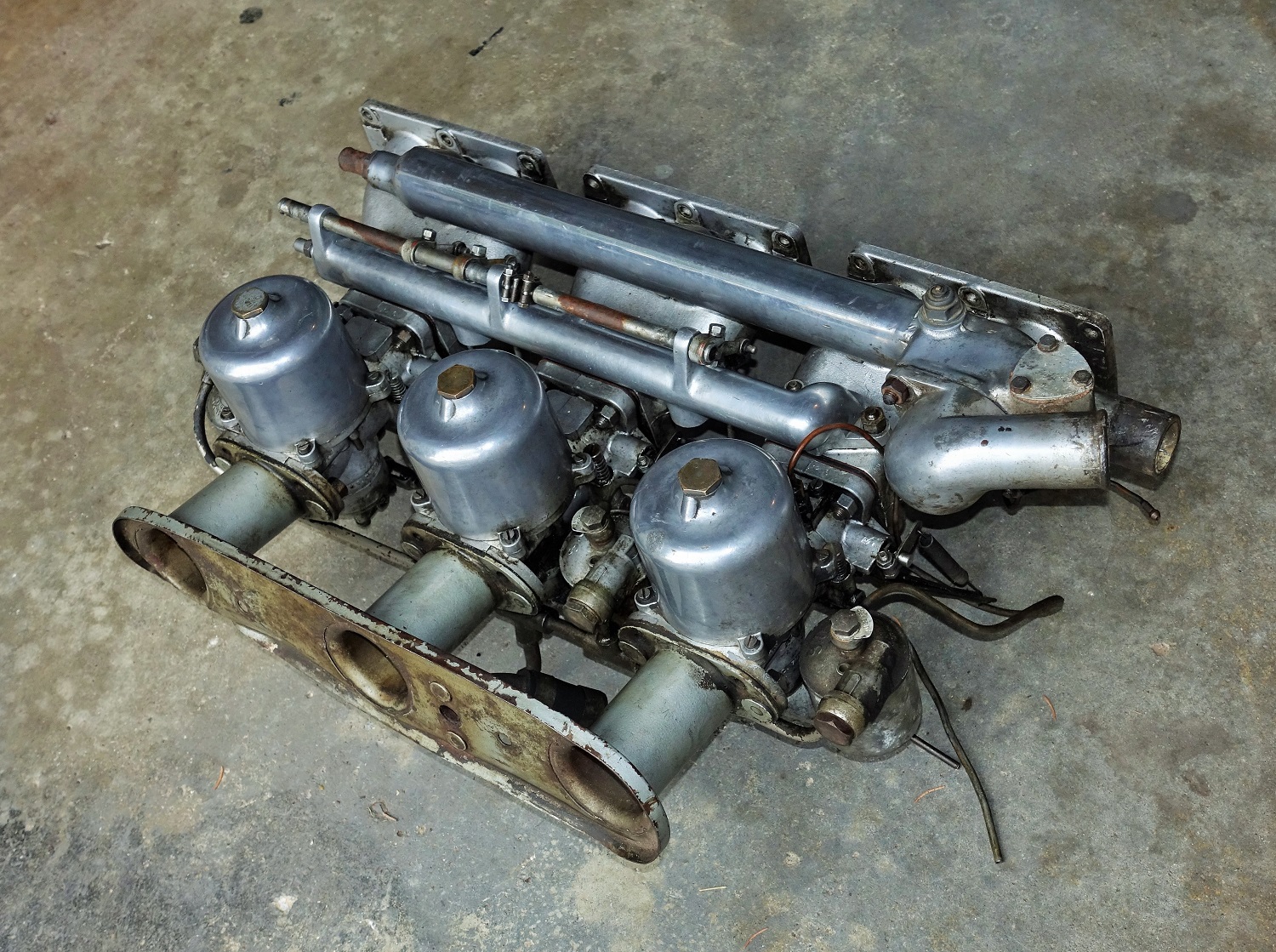
|
|
|
|
|
|
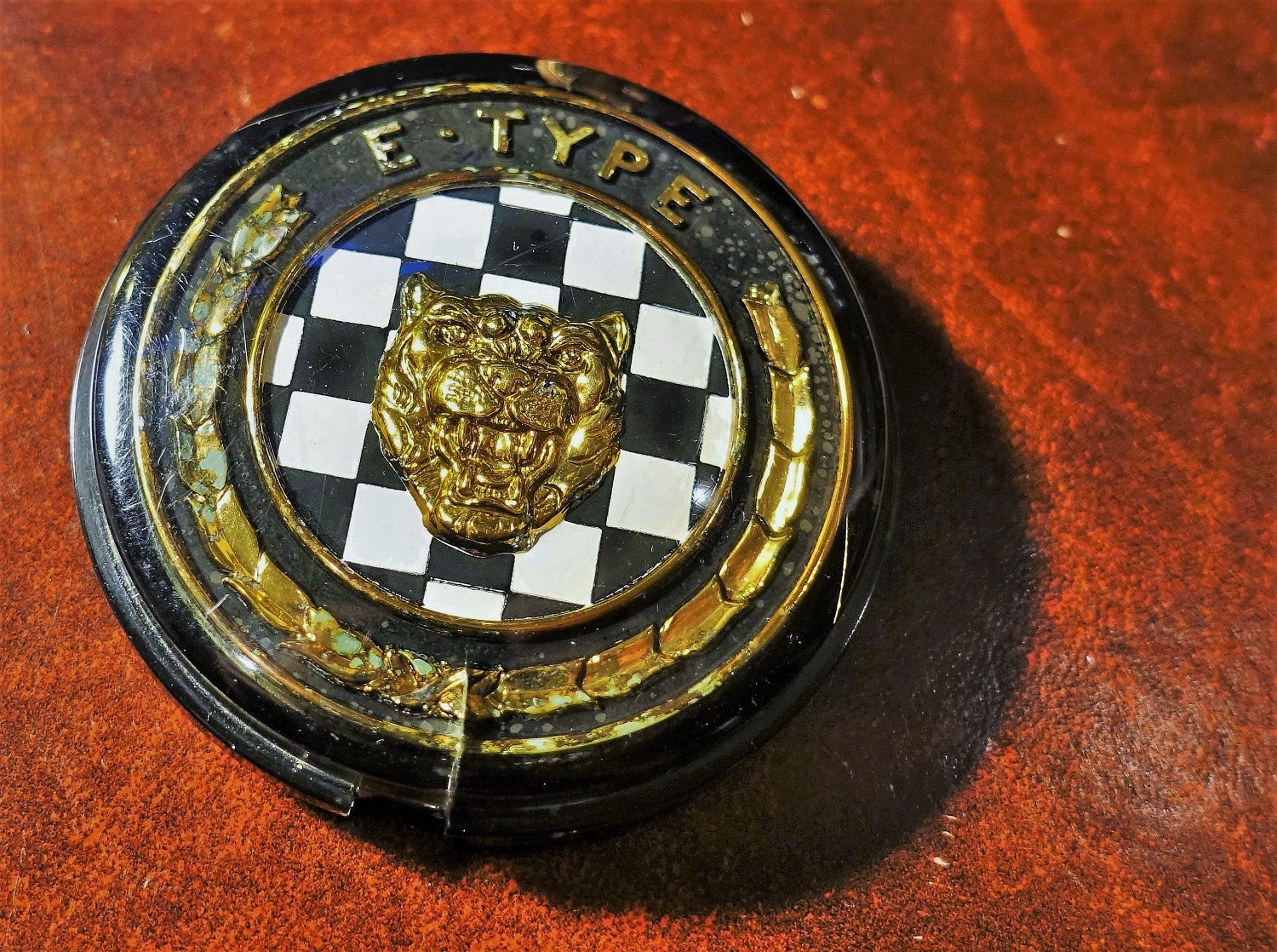
|
|
Horn button
Even though this E-type horn button is discolored and has some cracks, it, like all other parts of the E-type, still presents elegantly.
|
|
|
|
|
|
Oil filter head with filter removed
This filter head is seen mounted on the lower central right-hand side of a 3.8-liter E-type engine block. Various sorts of filter heads were used on the different versions of XK engine.
|
|
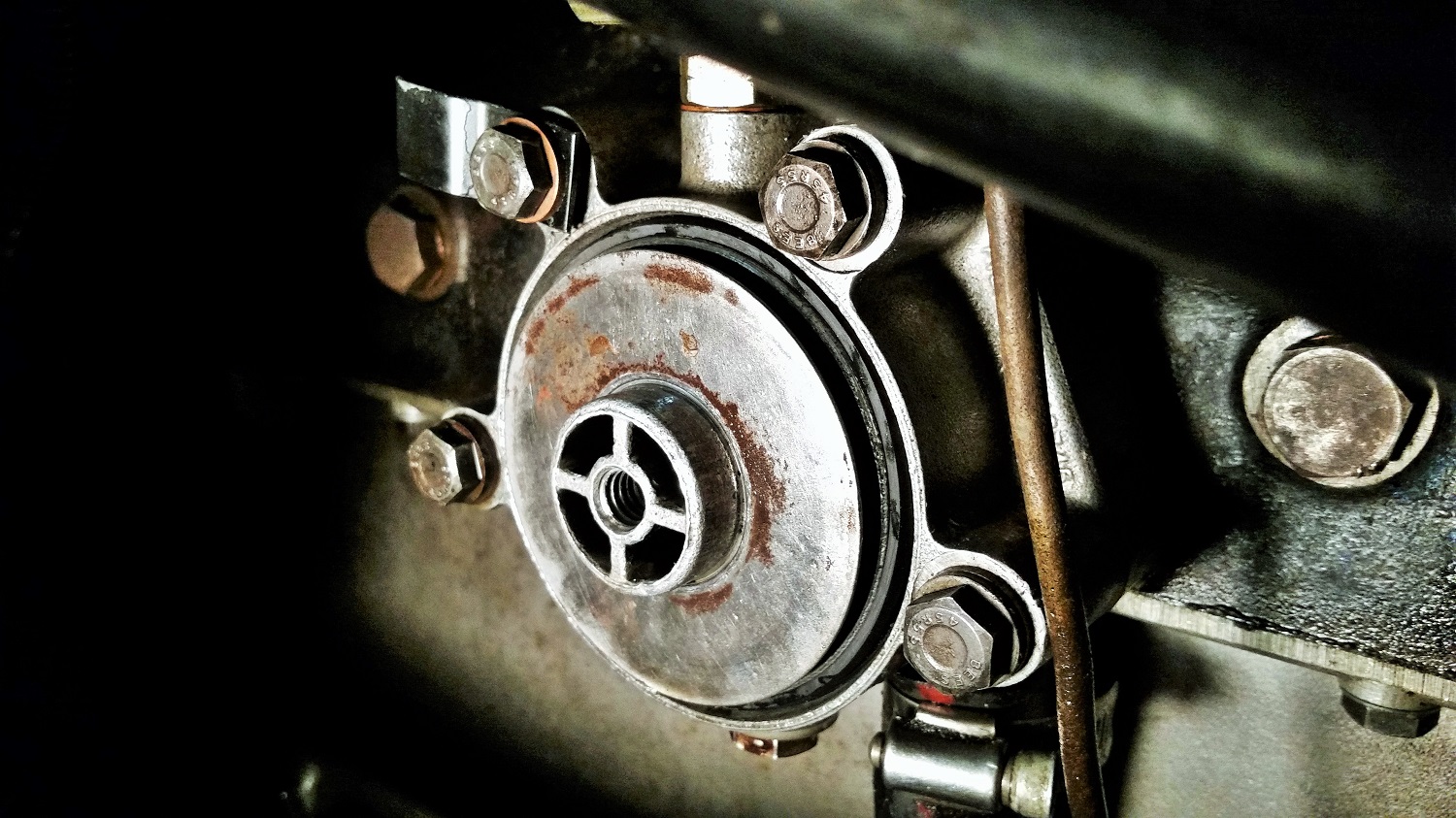
|
|
|
|
|
|
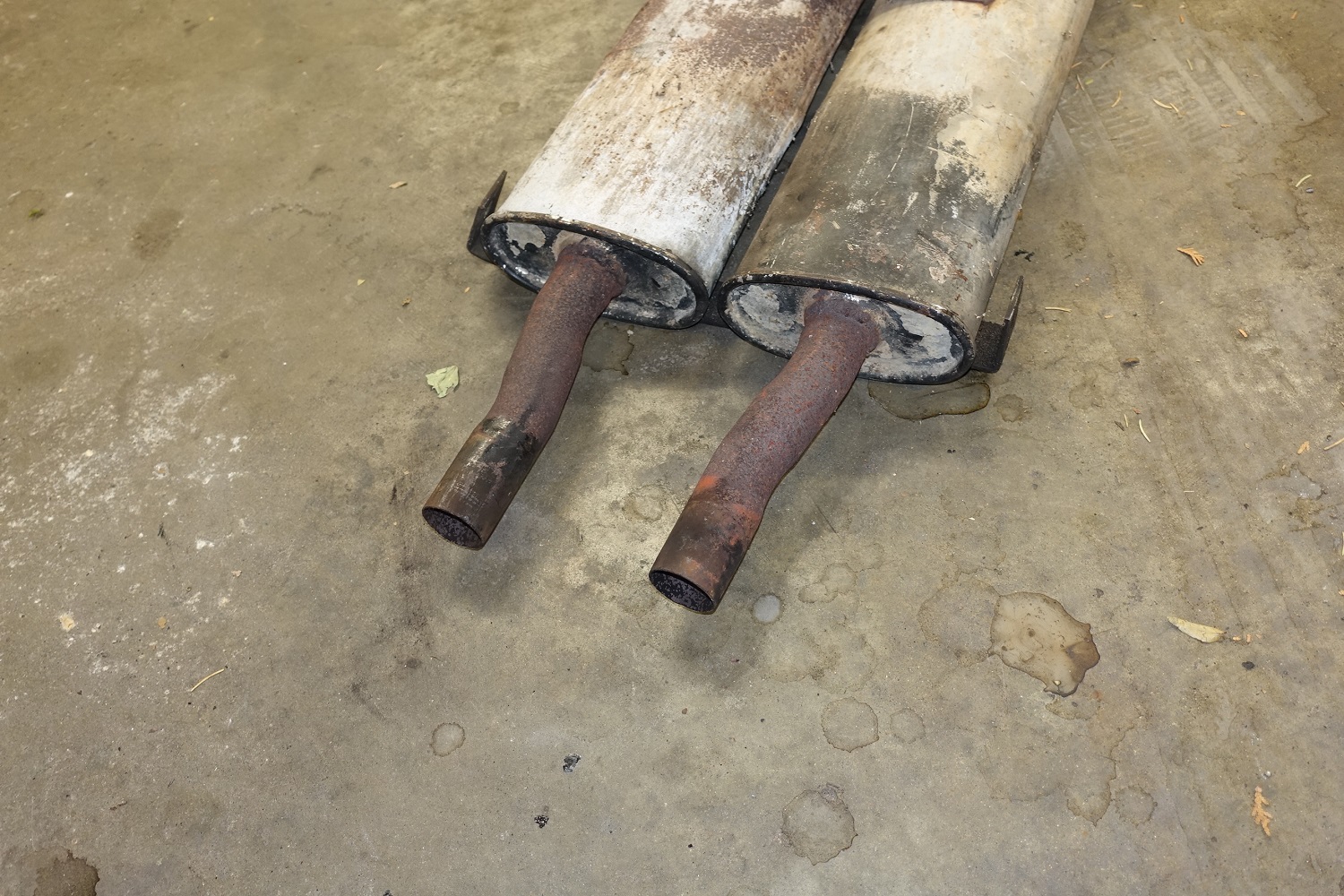
|
|
Muffler assembly
This muffler assembly spent many decades under a Series 1 E-type Jaguar. It was originally acquired as a replacement by aftermarket supplier J.C. Whitney.
|
|
|
|
|
|
Series 1 coupe with hatch open.
This 4.2-liter coupe has the later-style trimming in the rear storage area.
|
|
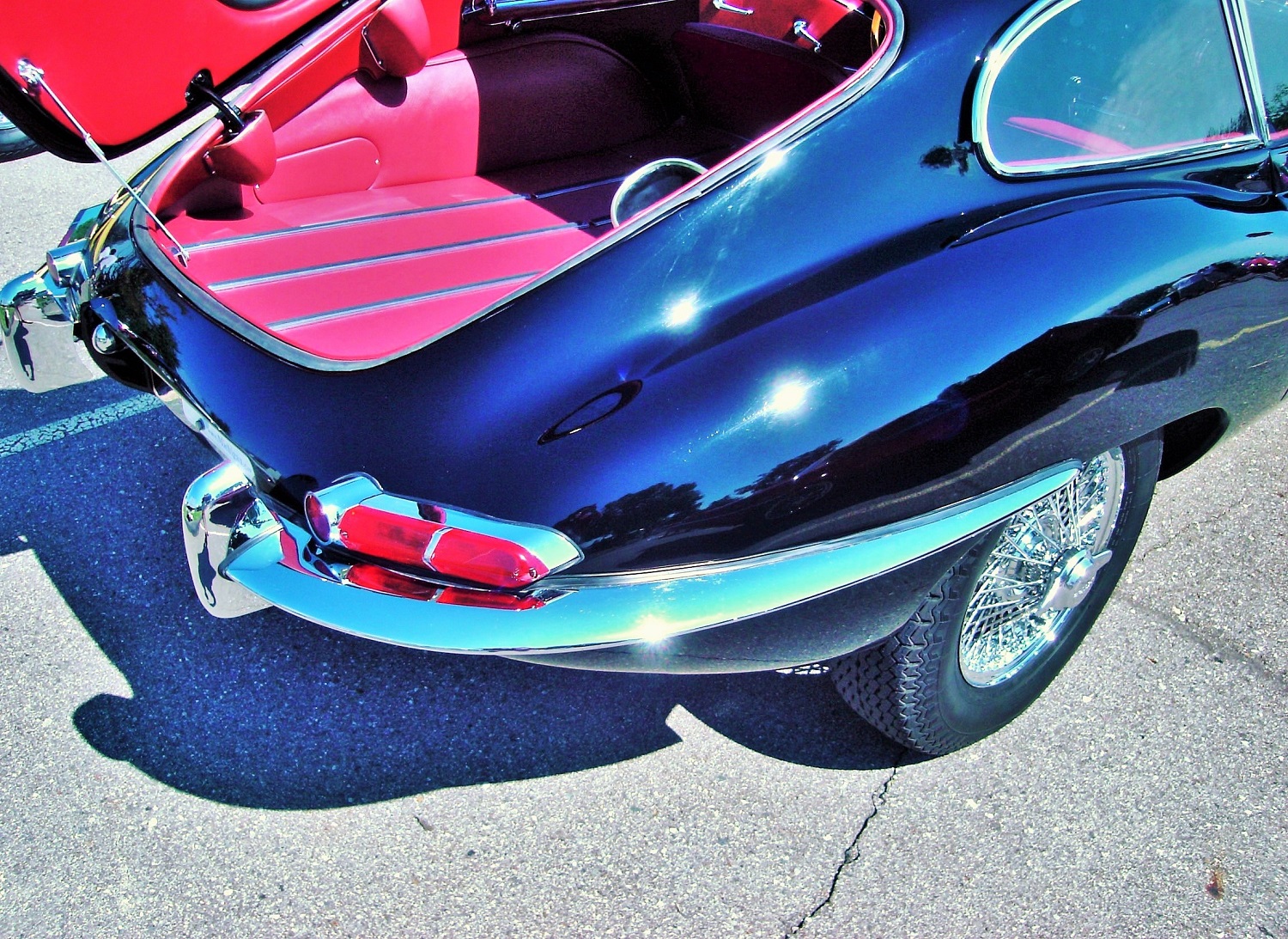
|
|
|
|
|
|
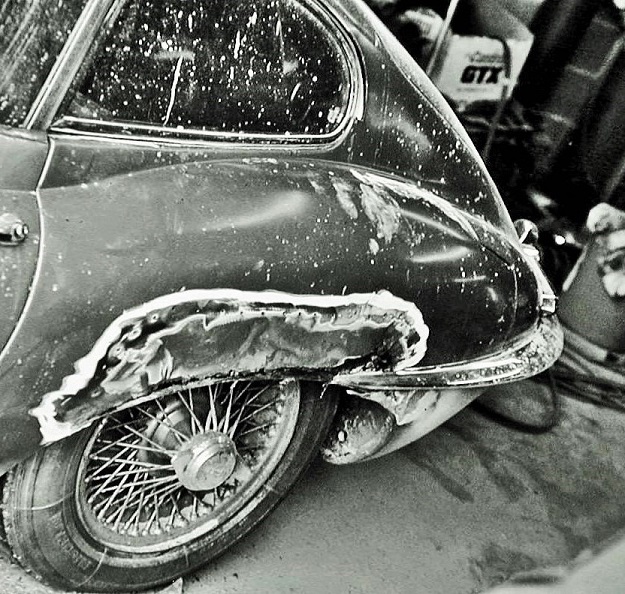
|
|
3.8-liter coupe undergoing body repair.
By the time this rust repair was being made, in the mid 1970s, the fender had already been repaired one previous time.
|
|
|
|
|
|
Face of a 3.8-liter cylinder head.
A combustion chamber is showing in the lower right, with the intake valve on the to the lower right of the spark plug. The exhaust valve is directly to the left of the spark plug.
To the upper left of the exhaust valve is the oblong port that takes coolant from the block to the cylinder head to cool the area around cumbustion chamber.
The round hole near the center top of the picture, above the exhaust valve, is a cylinder head stud hole.
|
|
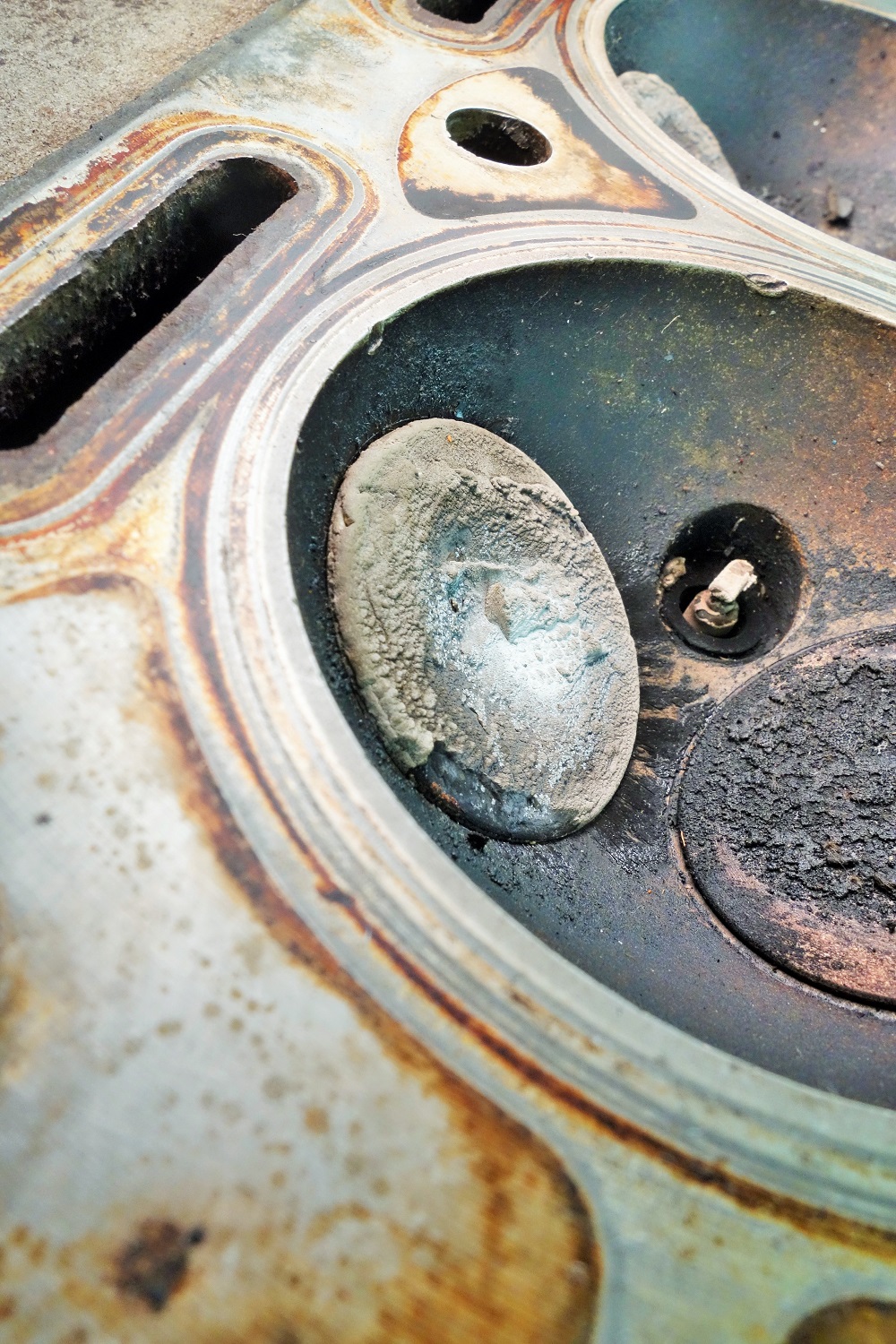
|
|
|
|
|
|
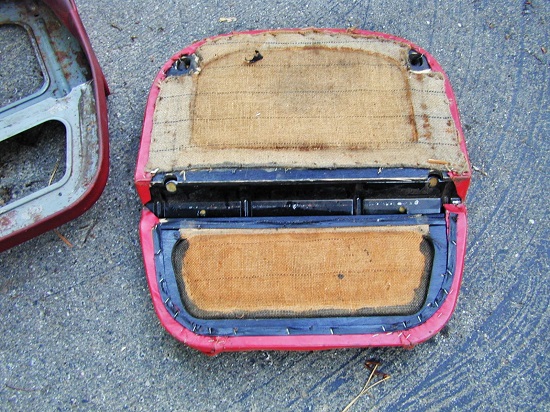
|
|
Original seat cushion.
This seat cushion is from a 1962 E-type roadster.
It still has its original upholestery still in place.
|
|
|
|
|
|
Valves and Tappets.
These valves have been cleaned and are waiting examination before being reviewed for going back into service.
As with many other components of E-types, the valves are beautifully shaped, and very distinct from most other valves.
This is another example of the appeal of E-types that extends well beyond their attractive external appearance.
|
|
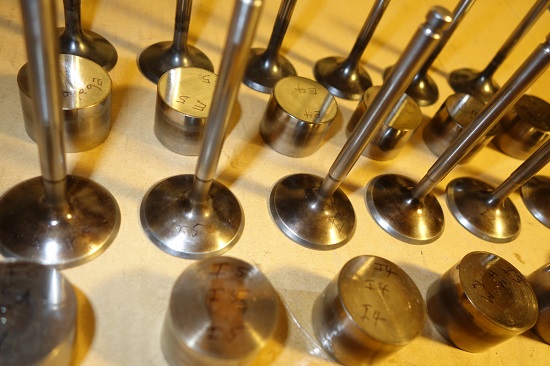
|
|
|
|
|
|
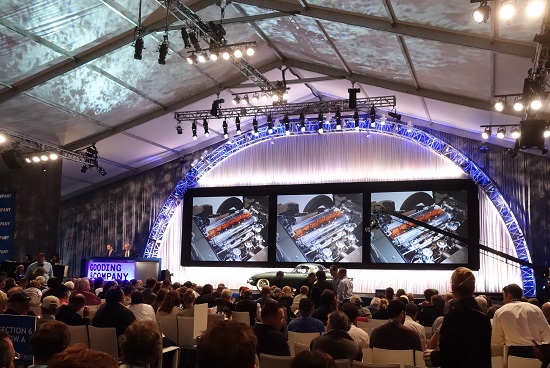
|
|
Gooding auction of an early E-type roadster.
As the appreciation of E-types by collectors has risen over the years their prices have gone up as well. Exceptional examples are sold at high-profile auctions around the world.
While the high prices makes it hard for some people to purchase E-types, at the same time it does tend to protect them from the sort of neglect and mistreatment seen in some of the pictures in this web page.
|
|
|
|
|
|
License plate lights.
The license plate lights for early 3.8-liter E-types carried the Butlers name.
Later this was changed to a Lucas label.
|
|
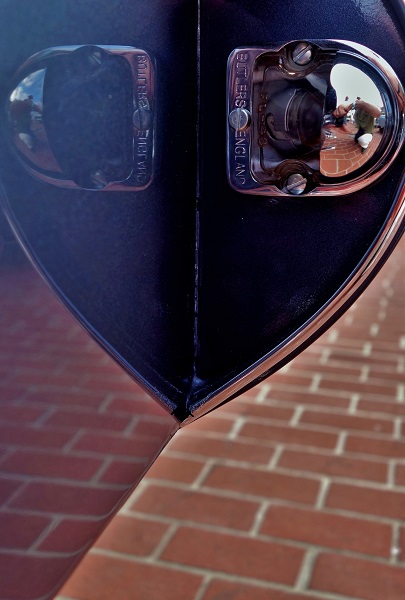
|
|
|
|
|
|
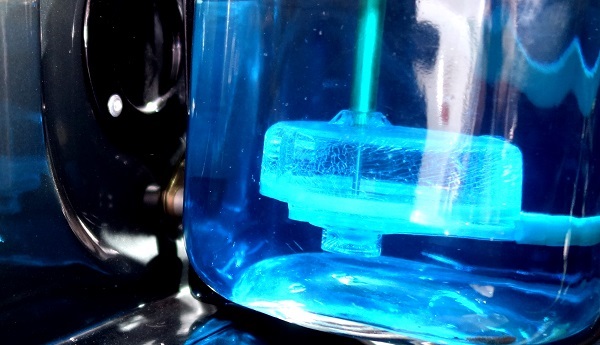
|
|
Windshiled washer mechanism.
This view of the lower part of the windshield washer bottle shows the reservoir mechanism near the bottom.
This reservoir collected an aliquot of fluid that would be ejected onto the windshield after a momentary acutation of the windshield washer switch.
|
|
|
|
|
|
E-type coupe in the shop.
This picture from the East Coast in the early 1970s shows an E-type coupe in for body repair. Around it are other cars of the era, awaiting various sorts of work, including the 356 Porsche in the foreground (also in for bodywork).
A very different situation from now, where E-types are given full restorations with great attention to originality.
|
|
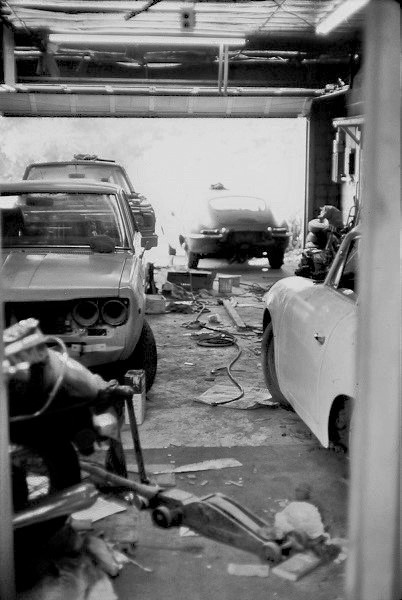
|
|
|
|
|
|
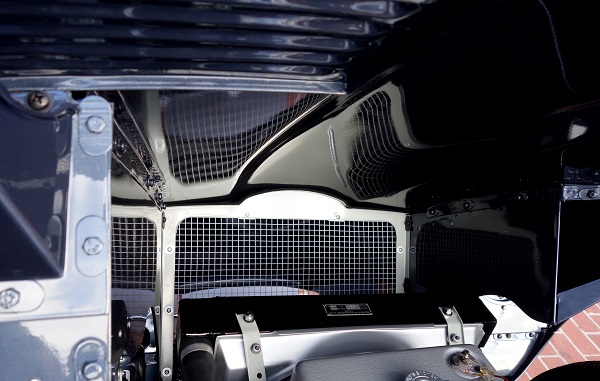
|
|
Looking up the intake path on a 3.8-liter car.
Looking from over the exhaust manifolds down to the intake at the front of the bonnet with the bonnet raised we see the coarse filter screen used to protect the aluminum radiator from road debris.
On the left we just see the right side of the outlet of the left intake plenum that feeds the heater. On the far right we see the left side of the outlet of the right plenum that feeds air to the twin trumpets on the air filter shell assembly.
In the lower center is the top of the crossflow aluminum radiator used in 3.8-liter cars. The serial-number plate is seen screwed to the center of the top of the radiator.
On the top left is the inside of the welded-in louvers, with the front decending lip of the louver assembly apparent. To the lower right of this, near the center of the picture, is the inside of the power bulge running down the center of the bonnet. This bulge is not a styling exercise; it is needed for the bonnet to clear the front of the cylinder head.
|
|
|
|
|
|
Brake booster.
Brake booster and associated components seen looking from the front back at the left-hand side of the firewall on a left-hand drive car.
This was an unusual design for a brake boosting system, incorporating a rubber bellows. The design used for the later 4.2-liter cars was of a more conventional design.
|
|
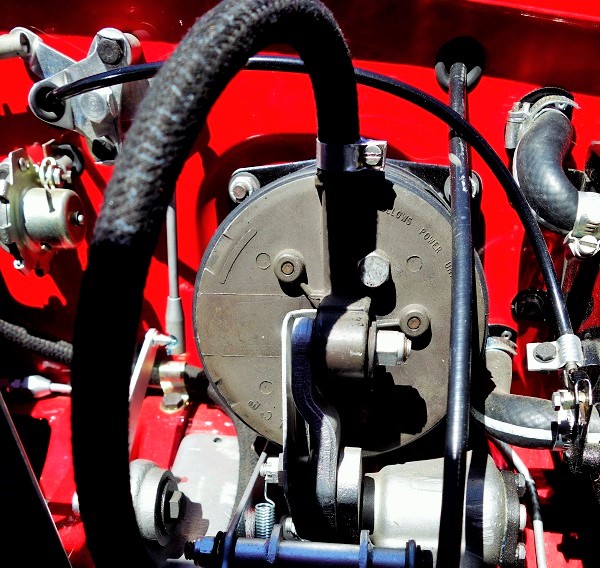
|
|
|
|
|
|
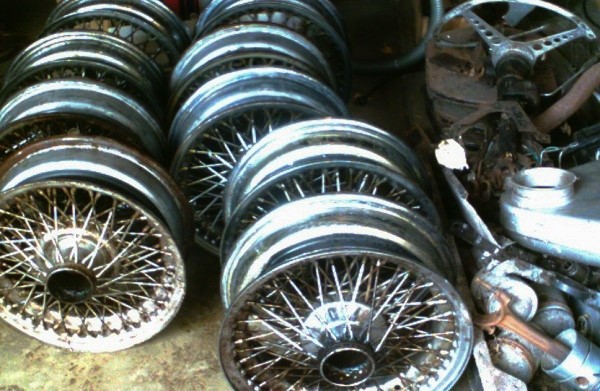
|
|
Wire wheels from Series 1, 1.5 and 2 E-types.
On the left is the Series 1 type wheel, with the dished-in center hub.
On the right is the later Series 1.5 and 2 wheel with the non-dished center hub.
|
|
|
|
|
|
Series 1 cowel.
This view of a Series 1 cowel area shows the three windshield wipers employed on the two-seater Series 1 and 2 cars.
When the E-type was introduced in 1961 the three windshield wipers were a noticable and often commented-on feature.
|
|
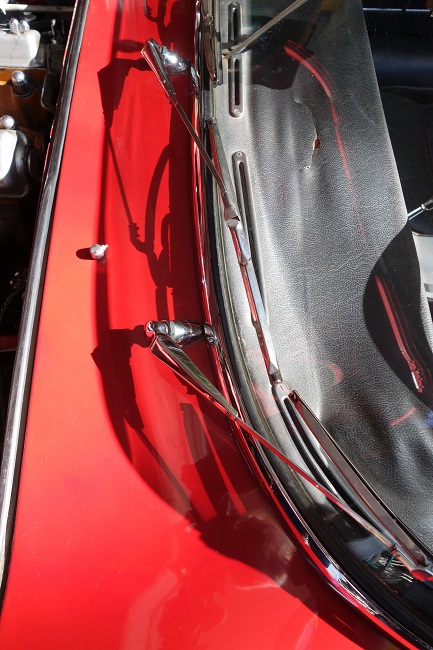
|
|
|
|
|
|
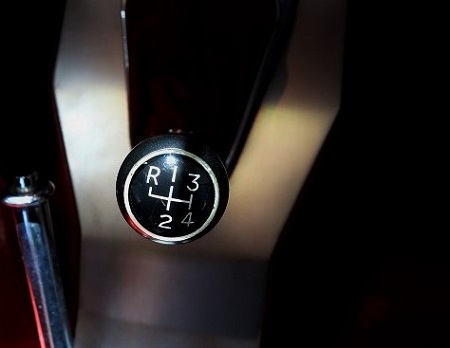
|
|
An original 3.8-liter shift knob.
This shift knob is an original on a 3.8-liter car.
Some (perhaps all) reproduction knobs use a significantly-different lettering.
|
|
|
|
|
|
Fan belt tensioner.
The early 3.8-liter cars had manual fan-belt tensioning.
Later 3.8-liter cars had this spring-loaded system to help maintain tension on the drive belt for the water pump and generator.
|
|
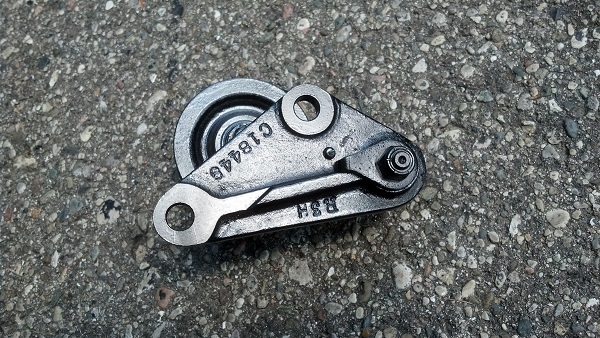
|
|
|
|
|
|
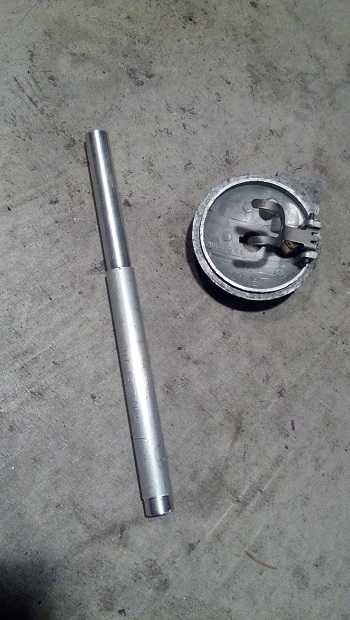
|
|
Carburetor float-chamber adjustment tool.
This is not a factory tool, but serves to set the float chambers in the carburetors.
A cover to a float chamber (inverted) is shown next to the tool.
|
|
|
|
|
|
Rear deck of a V-12 roadster.
This view of the rear end of a V-12 roadster shows the great variation that occurred over the production run of the E-type.
Among the changes are the shift of the central license area downward, with the rear now sweeping all the way across instead of cut out in the central region.
Associated with this is the extension of the rear bumper across the rear, and the lowering of the overriders to below the bumper line. These late overriders are now rubber and extend further to the rear in order to meet U.S. crash-protection regulations.
The labeling on trunk now shows a "V12" symbol instead of a denotation of the displacement. Initially, the 3.8-liter cars just had the "JAGUAR" label. The "E-TYPE" label came in with the 4.2-liter Series 1 cars. These cars also had a "4.2" label to denote the then-new displacement.
|
|
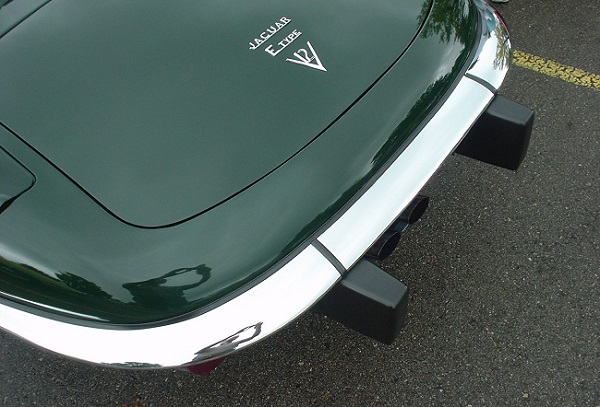
|
|
|
|
|
|
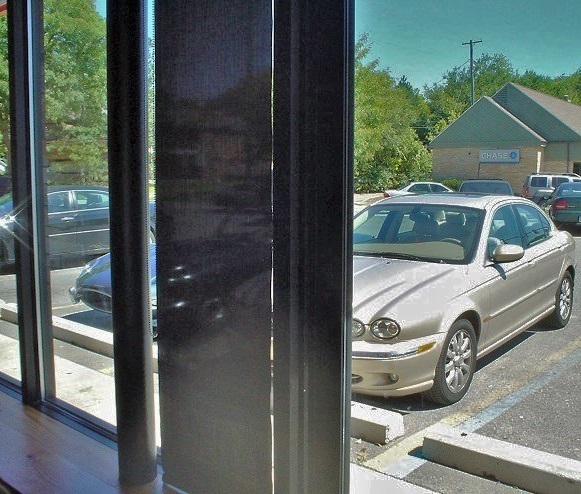
|
|
Two Jaguars in a parking lot.
On the left is a Series 1 E-type roadster, with a more modern X-type compact sedan on the right.
|
|
|
|
|
|
Looking directly down on an early 3.8-liter engine.
The complexity of the early 3.8-liter throttle linkage is very evident along the top of this picture.
This arrangement was simplified early on when the throttle linkage and air balance pipe were modified to reduce the number of parts and associated required adjustments.
Later yet, when the 4.2-liter variant of the Series 1 cars came out, the multi-piece intake manifold was replaced by a single log-type manifold, and the throttle linkage was re-located to beneath the manifold. This gave a significantly simpler configuration.
With the later introduction of the Series 1.5 and then Series 2, with their U.S. Federally-mandated emission controls, the top end of the engine became more complex once again. This culminated in the very complex appearance of the V12 engine when it came out in 1972.
|
|
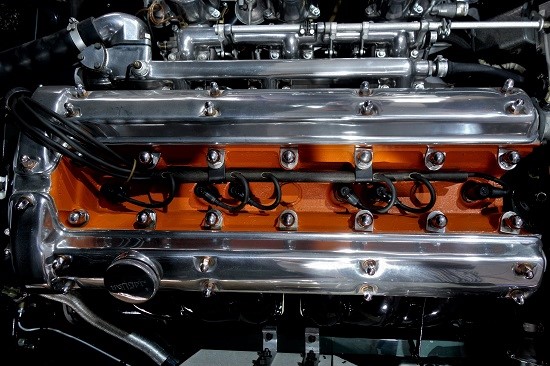
|
|
|
|
|
|
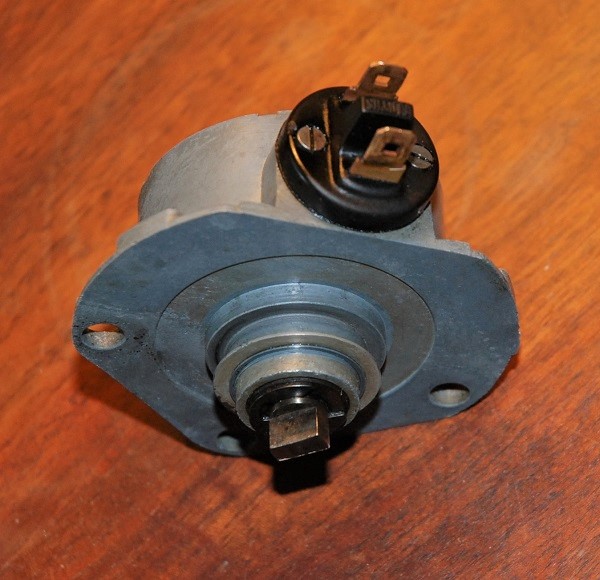
|
|
Tachometer transducer.
The Series 1 cars had this transducer to send an analog signal from the rear of the intake cam.
Basically, it was a generator that supplied a voltage related to the rotational speed of the cam. The tachometer, then, was basically a voltmeter, calibrated to engine R.P.M.
This arrangement was discontinued with the introduction of the Series 1.5 cars. It was just one of the many beautiful pieces of complexity of the early E-types.
|
|
|
|
|
|
Series 1.5 headlamp.
View of a Series 1.5 E-type headlamp. The original-type Lucas sealed-beam bulb is evident here.
As models progressed the headlamp was raised up in the bonnet, starting from the uncovered and slightly raised Series 1.5 lights (seen here), and finally, to the Series 2 lights that were raised higher still.
This was a result of the U.S. Federal safety regulations.
|
|
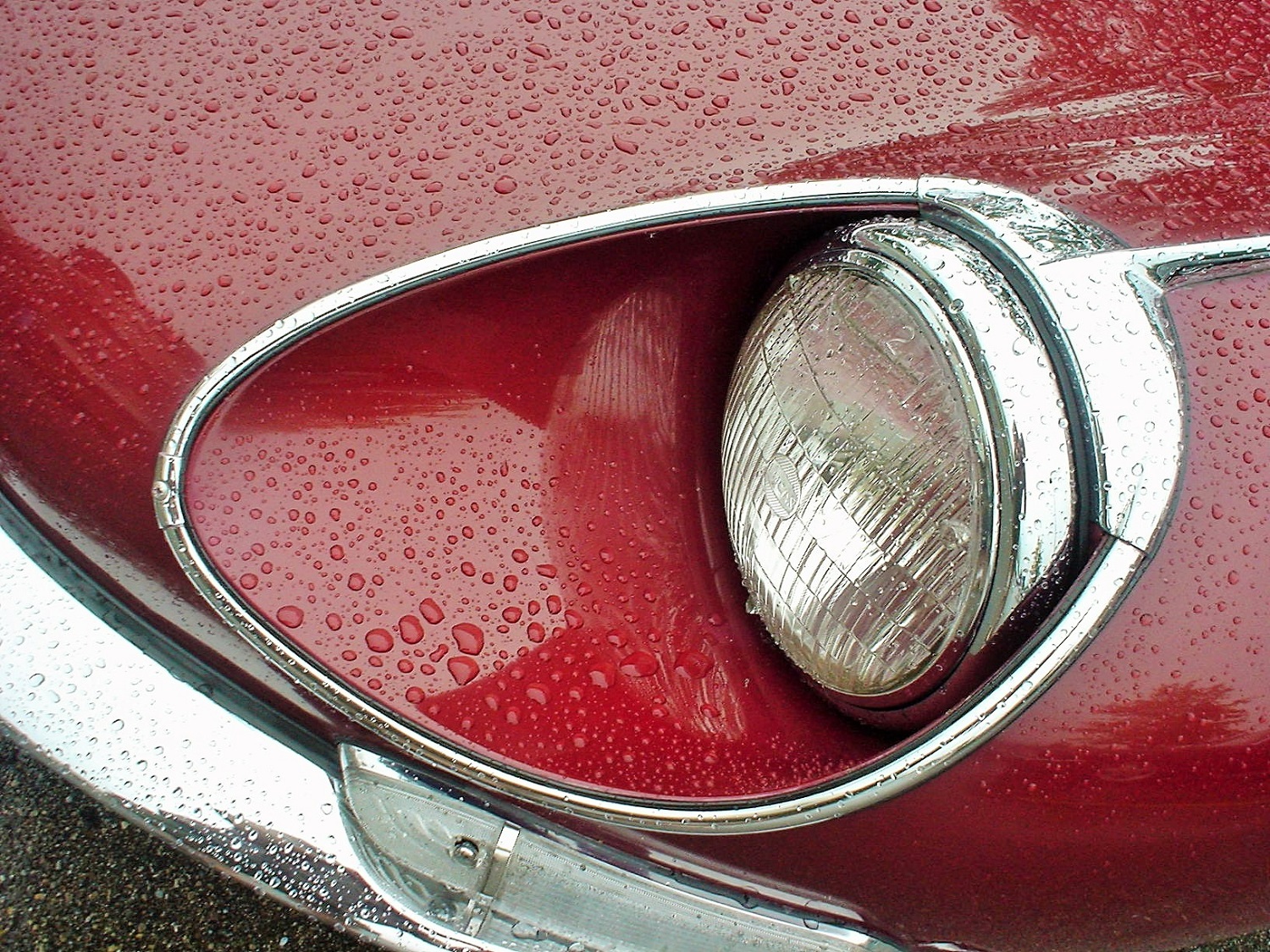
|
|
|
|
|
|
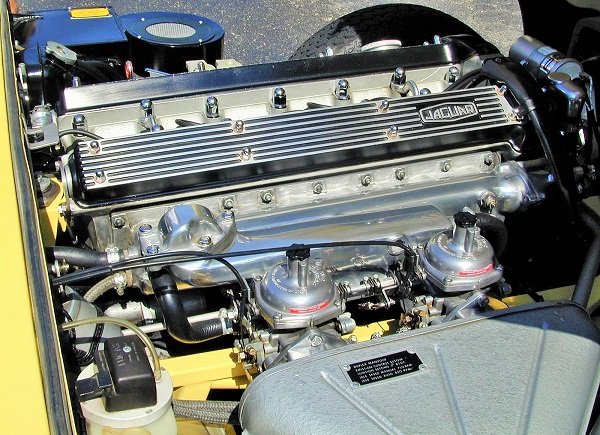
|
|
Series 2 engine.
This is a Series 2 engine with no crossover pipe. There were cast aluminum crossover pipes, black painted crossover pipes, and, as seen here, engines without crossover pipes.
|
|
|
|
|
|
Series 1 wire wheel.
A disassembled wire wheel.
The wire wheels fitted to E-types were 72-spoke units. Most were chromed, especially those sold into the U.S. market.
The wheels used a bigger center hub than the typical sports car of the era.
|
|
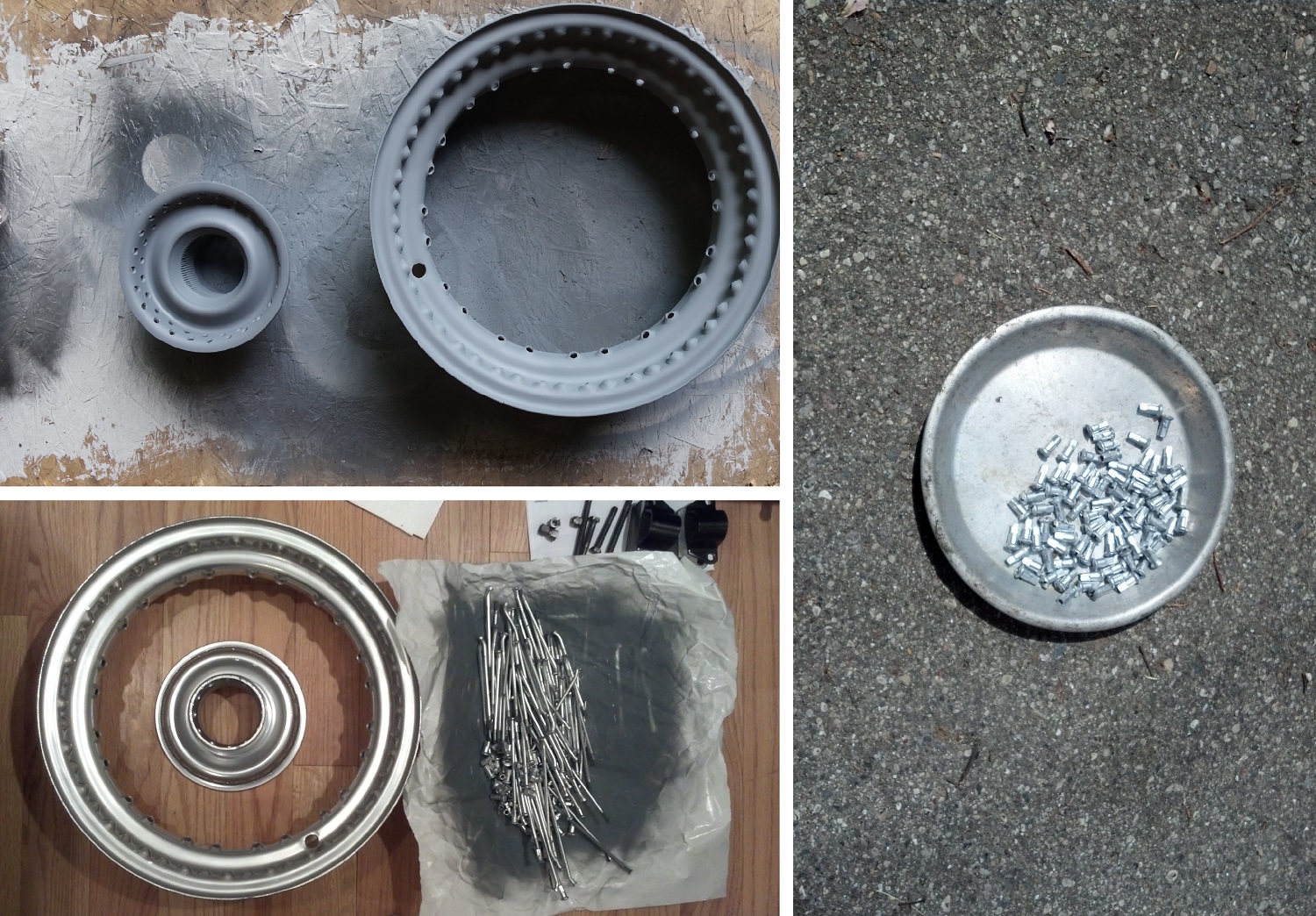
|
|
|
|
|
|
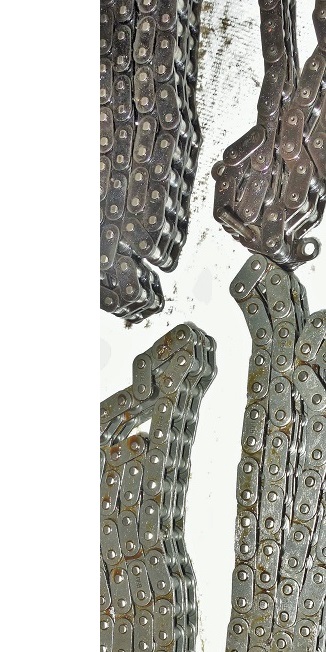
|
|
Timing chains.
The timing chains at the top of the picture were in service for many years. The ones below are modern replacements.
The XK engine uses two timing chains, a lower and an upper. They communicate through a double sprocket that scales down the rotational ratio, contributing to the small size of the camshaft sprockets, and hence the relative ease with which the head may be removed.
|
|
|
|
|
|
The first stage of modifications to the XK engine to meed U.S. emissions controls included a crossover pipe.
This sysetem came out in 1968, at the same time that the polished aluminm camshaft covers, as used on the XK engine since its introduction twenty years earlier, were replaced by finned machined and blacked covers.
However, almost as a hold-over, the crossover pipe was polished aluminum, in the manner of the earlier camshaft covers. The intake manifold remained polished aluminum.
This arrangement is seen here in the sun.
|
|
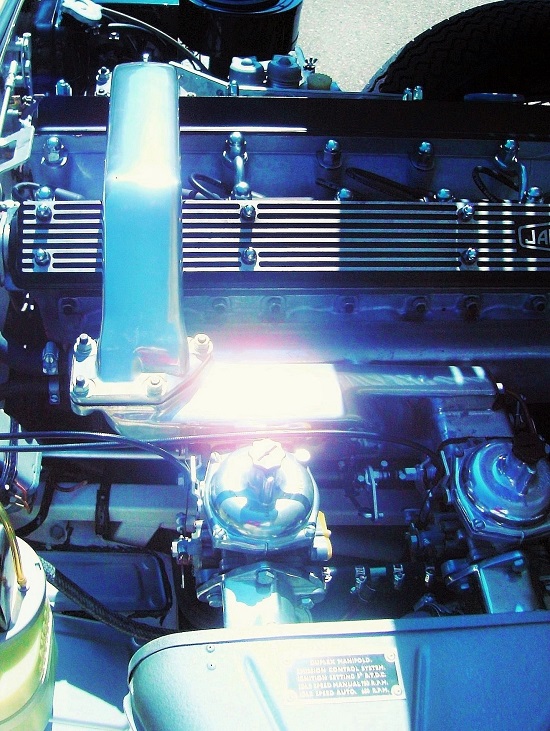
|
|
|
|
|
|
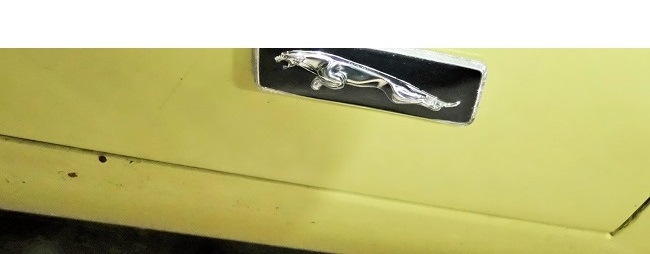
|
|
Leaping Jaguar trim on the side of the bonnet.
For model year 1971, the last year of the six-cylinder E-types before the Series 3 V-12 cars came out, this plastic Jaguar medallion was placed at the lower rear of both front wings.
This emblem was located in roughtly the same position as the T-key covers had been in ten years earlier on the first-500 E-types. It had a chromed appearance and a orientation, like the teardrop-shaped T-key covers.
This similarity was likely not planned. When this new model was coming out there was generally very little awareness of the outside-latch configuration, even among Jaguar enthausiasts.
|
|
|
|
|
|
Bottom view of 3.8-liter header tank.
The sheet steel header tanks can rust out if not protected.
This one was extensively rusted and repaired sometime in the past by pushing brass rivets through the larger holes and then coating the entire bottom of the tank with body filler.
This repair worked for many years. The tank is shown here with the filler removed.
|
|
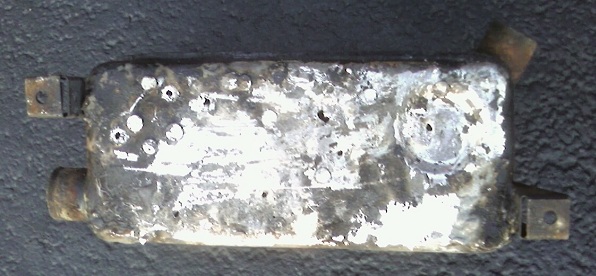
|
|
|
|
|
|
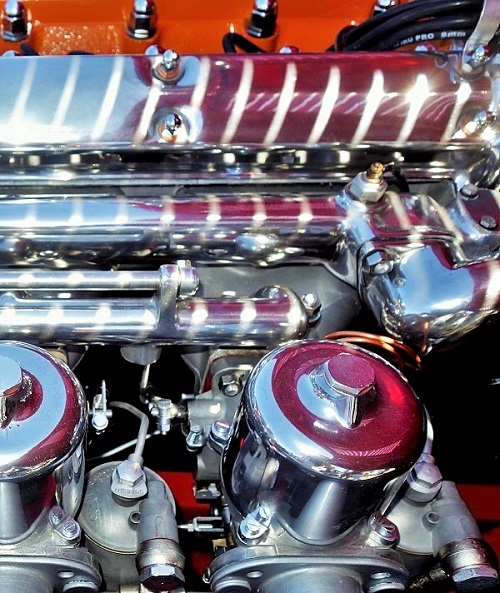
|
|
Carburetors and intake manifold from a 3.8-liter E-type.
The brass dash-pot covers and control-rod levers on this restored car have been plated, and closely match the original finish.
Often this plating is omitted and the brass components are polished, which looks nice, but does not accurately reflect the original state of the car.
The polishing of the aluminum has been done only on the appropriate surfaces, and the originally as-cast surfaces are present where they should be. For example, the float chambers.
|
|
|
|
|
|
Engine compartment of a U.S. emissions control Series 2 coupe.
The fabricated black heated-air crossover pipe is evident, although not hooked up.
Dual Stromberg carburetors have replaced the triple SU HD8 carburetors of the earlier non-emission-controlled engine.
There is much less polished aluminum here; only parts of the intake manifold and some of its fittings are polished. The carburetors have their as-cast finish.
|
|
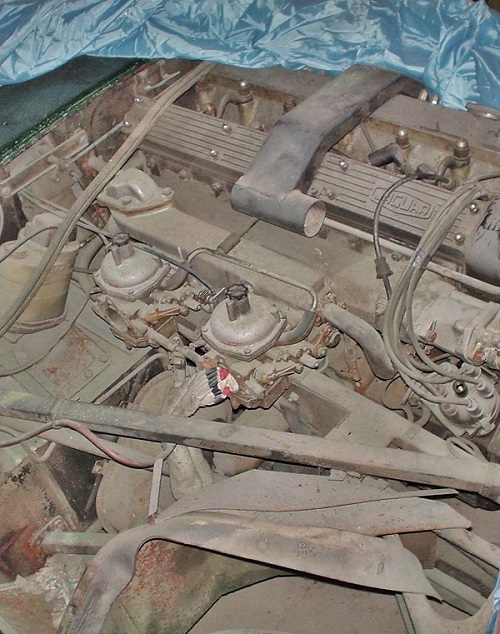
|
|
|
|
|
|
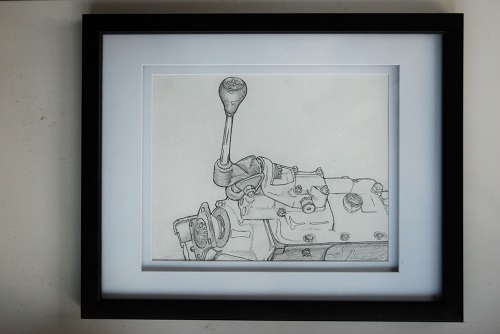
|
|
Illustration of the top section of a moss gearbox.
This drawing shows the somewhat complex shift linkage interface between the shift lever and the striker rods (not seen inside the top cover).
|
|
|
|
|
|
Lucas rear-view mirror.
This beautiful rear-view mirror is on a 4.2-liter Series 1 coupe.
This mirror is one example of the exquisite details that make up the E-type Jaguar, things, that when off the car, you can hold in your hand and appreciate.
|
|
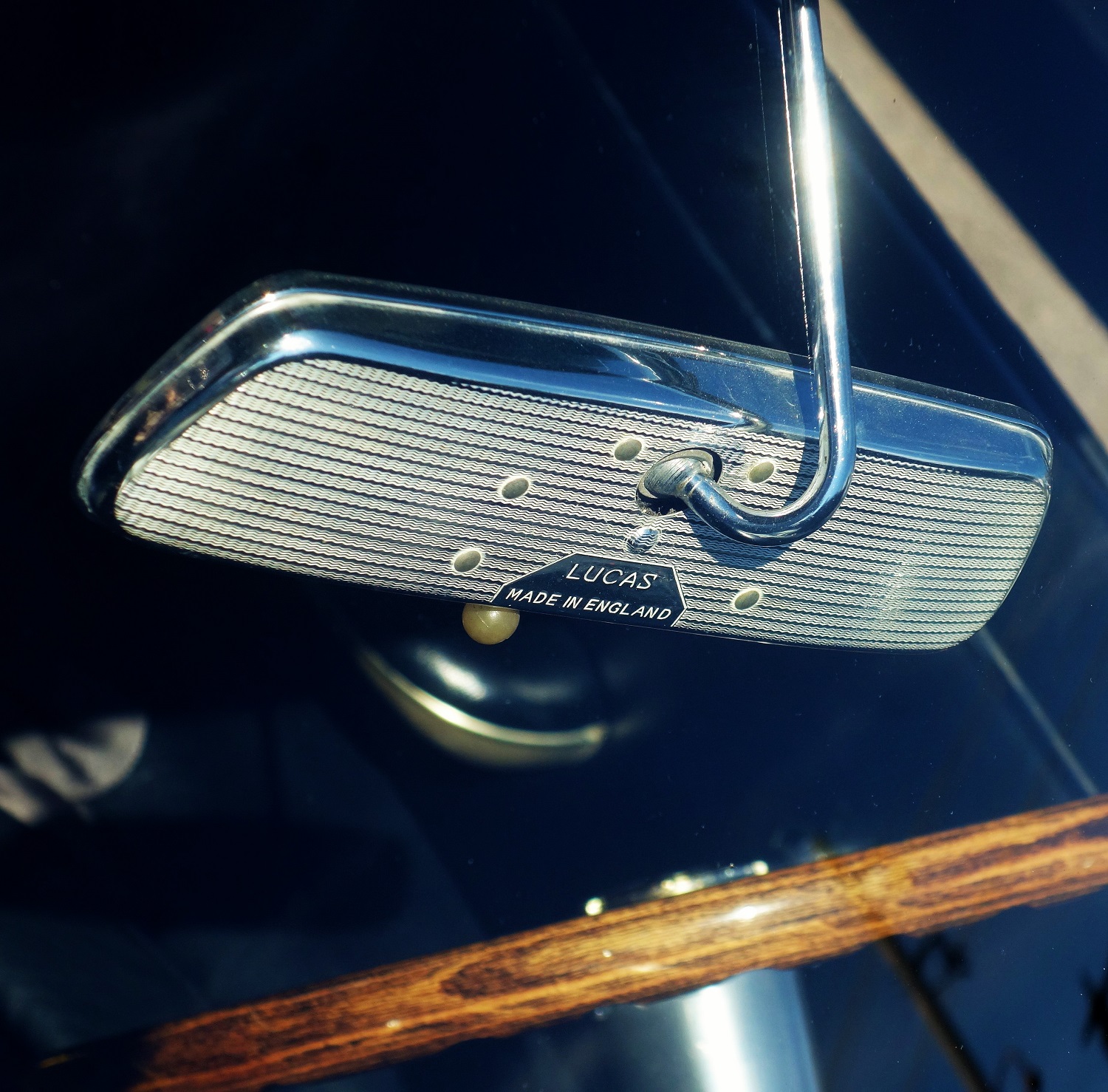
|
|
|
|
|
|
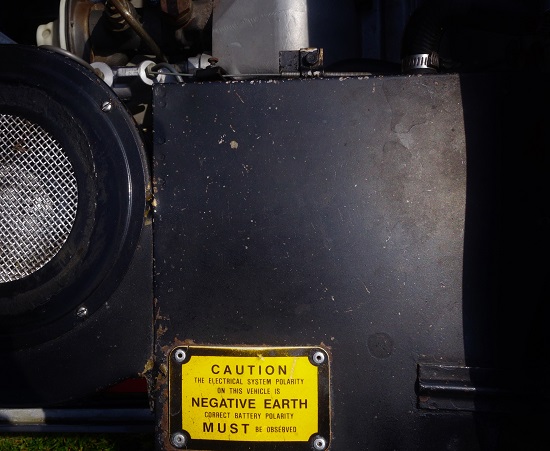
|
|
Negative earth warning plaque on a Series 1 4.2-liter E-type.
The transition from 3.8-liter to 4.2-liter E-type models included many changes.
Among these were the simplification of the intake manifold design, the introduction of a new fully-synchronized geargox, and the switch from positive to negative ground in the electrical system.
Many cars at the time (1965) were already negative ground, and this was becoming the worldwide standard.
|
|
|
|
|
|
Porcelian-covered manifolds.
The porcelian on the exhaust manifolds sometimes did not last long.
Here only a portion remains along the top of the manifolds.
There is a great range in finishes on modern reproduction manifolds and modern coatings on original manifolds. Some are very shiny, as were the originals, while others are various ranges of matte, all the way to an almost completely-matte porcelian coating.
Some of the modern manifolds use a form of paint instead of porcelian.
|
|
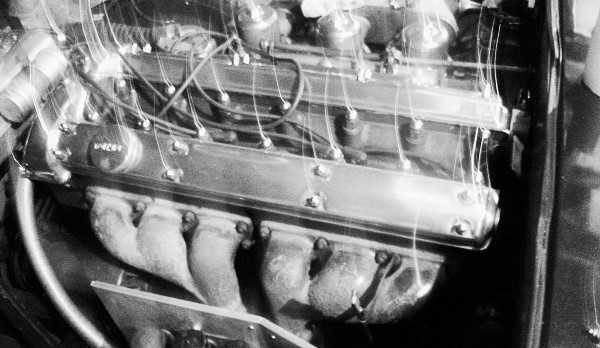
|
|
|
|
|
|
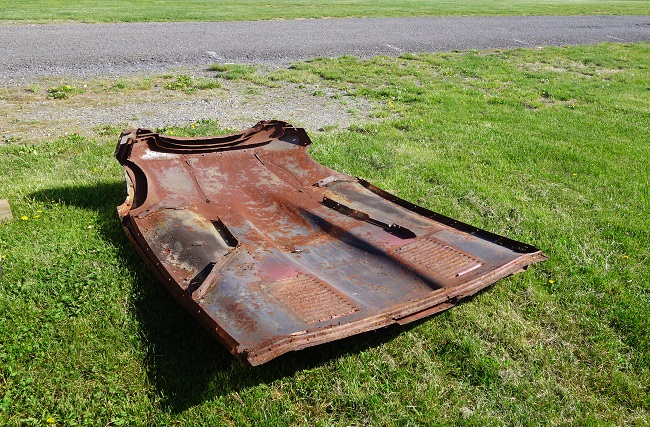
|
|
Stack of E-type bonnet center sections.
The only body-panel seam that was open on the E-type was along the edges of the bonnet center section.
This seam was covered with chrome beading, but was the outlier in body construction.
When welded shut and leaded over these seams can flex with motion of the car and cause indentations that are apparent on the surface of the fenders.
|
|
|
|
|
|
Four-way flasher switch.
In response to regulations, Jaguar added the four-way flasher function (also called "hazard warning").
Here the added switch is seen on the lower left underside of a 2+2 dashboard, circa about 1966.
Note that the reset for the tripometer has had to be moved from directly under the dash to a location to the left of the new four-way flasher switch.
|
|
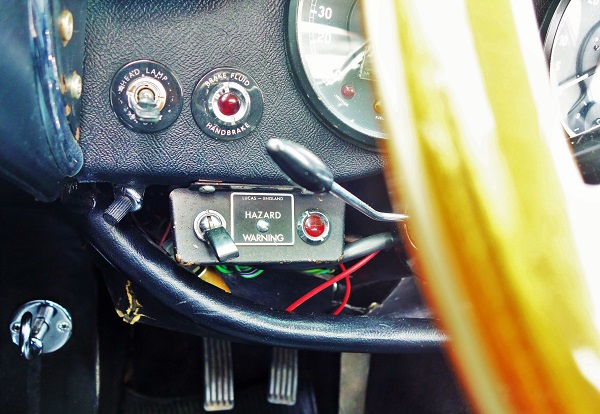
|
|
|
|
|
|
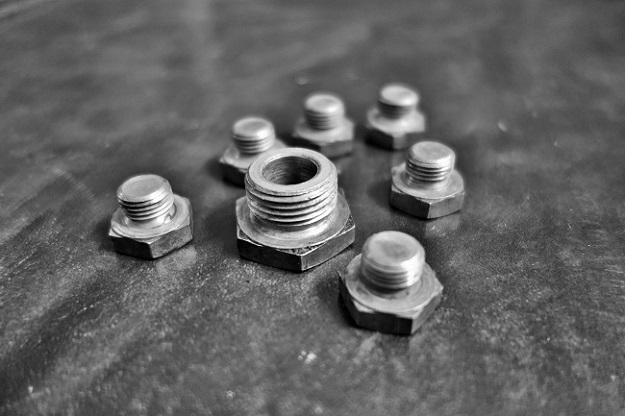
|
|
Oil-gallery plugs.
These plugs, with appropriate washers, are used to seal the oil gallery running along the lower right side of E-type XK-engines.
The small ones seal from the side, and the large from the rear. There is an additional plug on the front, that is not seen here.
The oil is fed into the middle section of the gallery from a pipe leading from the oil pump, then runs along the gallery to various points of the engine needing lubrication, including the main bearings, oil-feed to the head (through an external pipe), and the lower timing-chain tensioner.
The oil is filtered before entering the timing-chain tensioner, at the front of the block, behind the timing-chain cover.
|
|
|
|
|
|
Upper timing-chain assembly from an XK engine.
This disassembled timing-chain mechanism tranlates the cam timing signal from the lower timing chain to the cams.
|
|
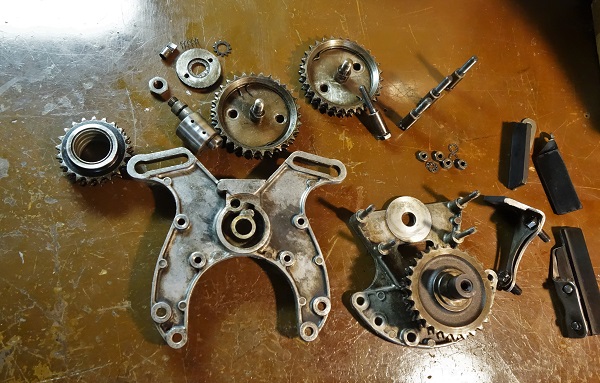
|
|
|
|
|
|
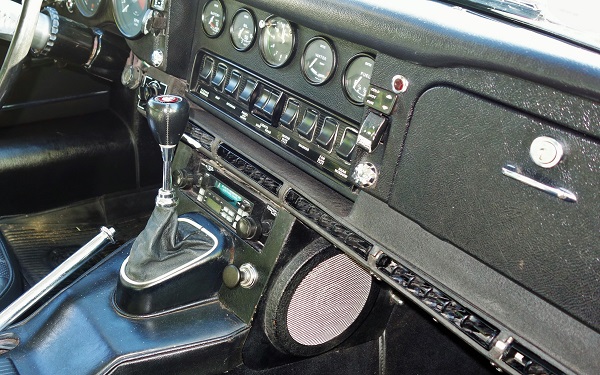
|
|
Air conditioning system on a Series 2 2+2.
Air conditioning was almost certainly not planned for the E-type during its conception. When it was decided to add it, it was locagted in a long, wide section below all three sections of the dash.
Given the challenges of putting air conditioning in the E-type, it was a reasonably good-looking installation.
|
|
|
|
|
|
Welded-in louvers on an early 3.8-liter roadster.
The louvers of early cars were created as seperate pieces and then spot-welded into the main central section of the bonnet.
This construction technique is clearly evident from the outside of the car; the transition between the louver section, brought up from below the surface of the main bonnet section, and the top layer of sheetmetal can be seen all around the louver section.
|
|
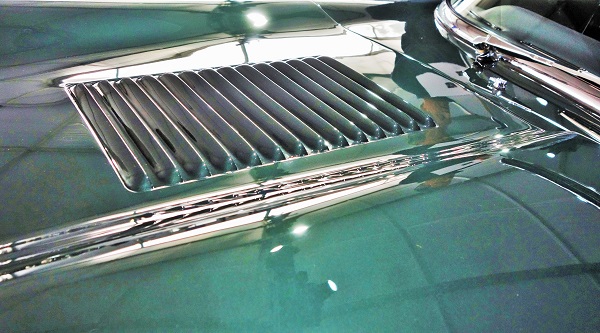
|
|
|
|
|
|
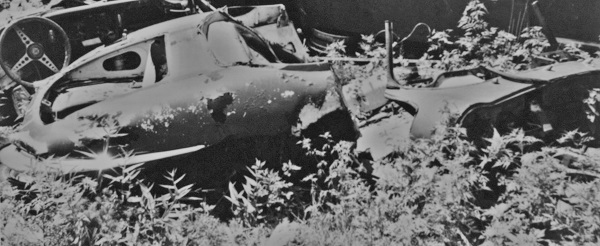
|
|
Collection of scrap E-types.
By the 1970s, when this picture was taken, E-types were not only readily available for a few hundred dollars (or less), but were rapidly being scrapped.
In some cases they were taken to landfills or scrapped for metal content. Some were parted out.
Today they are valued, and examples like this are still turning up and being rescued.
|
|
|
|
|
|
Broken-off stud.
This cam-cover stud is broken off below the surface of the aluminum front of the head.
Care must be taken in getting the remaining part of the stud out of the head, as the surrounding aluminum alloy is softer than the stud itself.
|
|
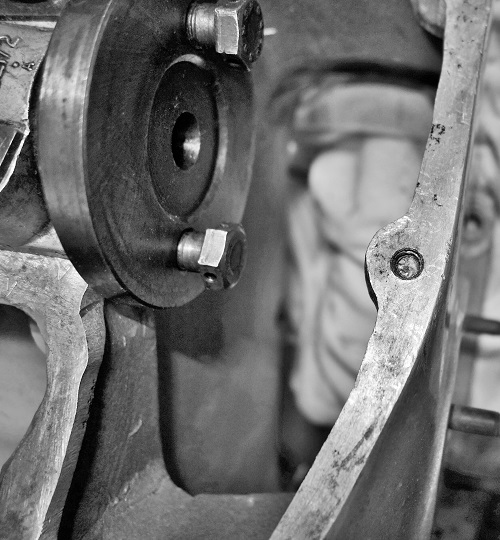
|
|
|
|
|
|
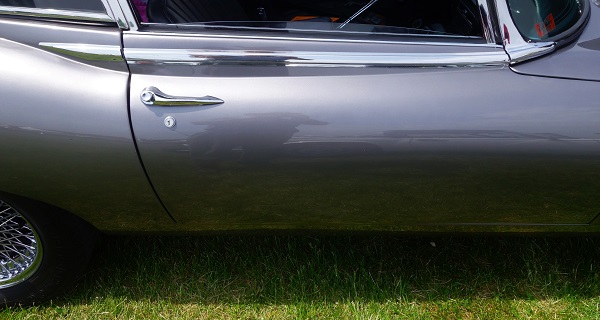
|
|
Right-hand side door from a Series 1 2+2.
Aside from the altered profile of the rear bodywork, the most obvious external difference between a 2+2 and a two-seater coupe is in the doors.
The doors were longer, but there were many other differences. The key opening for the door lock was no longer located on the end of the push-button used to open the door, but was situated in the bodywork, below the door handle.
The two-seater coupes did not have a chrome strip along the top of the door, and one was added. However, it was quite different from the door trim used on the roadster, consisting of a strip running only down the middle of the top section of the door (instead of covering the entirity of the top section, as in the case of the roadsters). In additon, at the rear of the top section of the door the trim strip line was continued by a small chrome "tail" extending past the rear of the door. the roadsters.
Thus, overall the trim on 2+2 doors was much more elaborate than that on the two-seater coupes.
|
|
|
|
|
|
Early thick-crossection steering wheel with original finish.
This early steering wheel shows its original finish.
Over time, the material used on these early wheels would "bunch up" in the manner shown here.
Not too many wheels are still in their original finish.
|
|
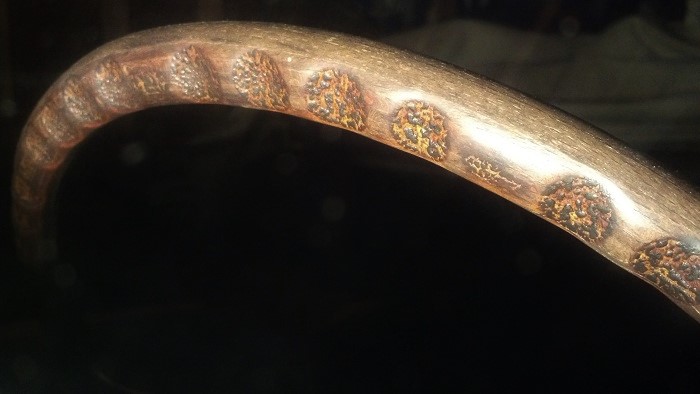
|
|
|
|
|
|
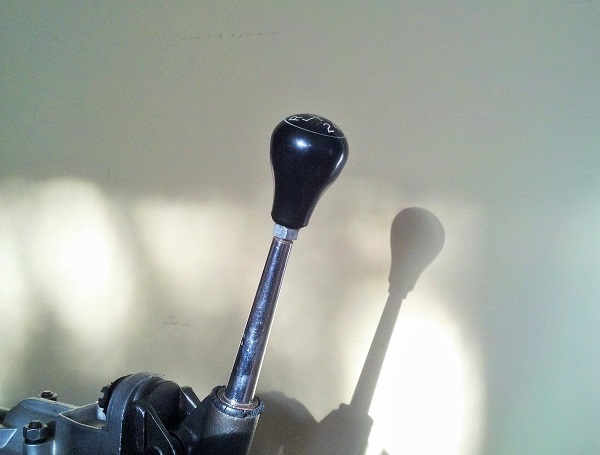
|
|
Early pear-shaped shift knob from a 3.8-liter Moss gearbox.
This original shift knob is mounted on a Moss gearbox from a 1963 E-type roadster.
The knob, shift lever and gearbox are in storage awating future use in a 3.8-liter E-type.
|
|
|
|
|

